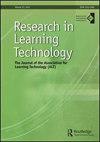Learning experience design for augmented reality
IF 1.2
Q2 EDUCATION & EDUCATIONAL RESEARCH
引用次数: 19
Abstract
Recent years have seen a growing interest in augmented reality (AR) technologies due to their potential for simulating real-life situations and creating authentic learning tasks. Studies have shown that AR enables engaging and interactive learning experiences (e.g. Bressler and Bodzin 2013; Klopfer and Sheldon 2010) and can benefit student learning (e.g. Bonner and Reinders 2018; Siegle 2019). However, although research in AR for education is not scarce, educators often do not have a learning experience design (LXD) approach that is supported by the recent findings of learning sciences and instructional design models. To bridge this gap, the present study introduces an AR-learning prototype developed by using SAM I (Successive Approximation Model I), and the Threshold Concepts Framework, employed for meaningful integration of AR into the learning process. A pre-survey and a post-survey method were utilised in the data gathering process to gauge students’ experience with the AR module. The findings show that the majority of students have not had educational experiences with AR prior to the study, and they struggled to find ways to incorporate this technology into their content areas in a meaningful way. Nonetheless, participants realised the value of AR and stated that they most likely would use this technology in the future. Based on the findings, the authors present a set of suggestions for instructors and LXDs, and provide recommendations for future research. This article is part of the special collection: Mobile Mixed Reality Enhanced Learning edited by Thom Cochrane, James Birt, Helen Farley, Vickel Narayan and Fiona Smart. More papers from this collection can be found here.增强现实学习体验设计
近年来,人们对增强现实(AR)技术的兴趣日益浓厚,因为它们具有模拟现实生活场景和创建真实学习任务的潜力。研究表明,AR可以实现引人入胜的交互式学习体验(例如Bressler和Bodzin 2013;Klopfer and Sheldon 2010),并对学生的学习有益(例如Bonner and Reinders 2018;Siegle 2019)。然而,尽管增强现实在教育方面的研究并不稀缺,但教育工作者往往没有学习体验设计(LXD)方法,这种方法得到了学习科学和教学设计模型的最新发现的支持。为了弥补这一差距,本研究引入了一个使用SAM I(连续逼近模型I)和阈值概念框架开发的AR学习原型,用于将AR有意义地整合到学习过程中。在数据收集过程中,采用了预调查和后调查方法来衡量学生对AR模块的体验。研究结果显示,大多数学生在研究之前没有接受过AR的教育经历,他们努力寻找方法,以一种有意义的方式将这项技术融入他们的内容领域。尽管如此,参与者意识到增强现实的价值,并表示他们很可能在未来使用这项技术。基于这些发现,作者为教师和lxd提出了一组建议,并对未来的研究提出了建议。本文是由Thom Cochrane, James Birt, Helen Farley, Vickel Narayan和Fiona Smart编辑的特别集合:移动混合现实增强学习的一部分。更多的论文可以在这里找到。
本文章由计算机程序翻译,如有差异,请以英文原文为准。
求助全文
约1分钟内获得全文
求助全文
来源期刊

Research in Learning Technology
EDUCATION & EDUCATIONAL RESEARCH-
CiteScore
6.50
自引率
0.00%
发文量
13
审稿时长
20 weeks
 求助内容:
求助内容: 应助结果提醒方式:
应助结果提醒方式:


